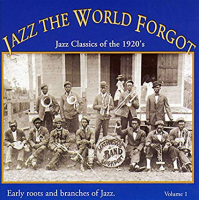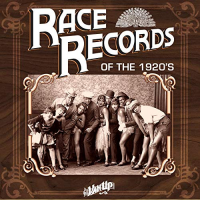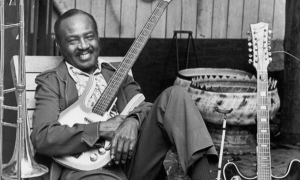Home » Jazz Articles » Under the Radar » The Black Swan: A History of Race Records
The Black Swan: A History of Race Records

Calling oneself or being referred to as a race man or race woman became a way to display pride in being an African American.
—Guthrie P. Ramsey, Jr
The sensitivity around segregation in the music business of this era can be viewed from the perspective of national events. Bookending the birth and demise of Race Records were some of the worst incidents of white-on-black violence in American history. For two days in July 1910, a white mob in the East Texas town of Slocum attacked black residents based on unsubstantiated rumors of a fraudulent business deal. There are estimates that as many as one-hundred blacks were murdered and many survivors fled their farms and homes, cutting the African American population of the town by half. The massacre was characteristic of a national wave of violence against blacks that intensified through the years when jazz was born. Post-World War I saw a shortage of laborers in the Northeast and Midwest and spurred the Great Migration of Southern blacks to the industrial centers of the country. White troops returned home, the economy weakened, and white antipathy toward blacks led to vicious racial riots in East St. Louis, Illinois and Houston, Texas. The same labor issues led to the worst violence during the Red Summer of 1919. Not confined to summer, racial riots occurred in almost forty cities across the country from late winter through fall of that year, resulting in hundreds of deaths in black communities. In 1921, thousands of whites in Tulsa, Oklahoma attacked thirty-four square blocks of that city's Greenwood community, a national center of African American commerce known as Negro Wall Street of America. With guns, bombs, and even aircraft, Greenwood was left in ashes, the death toll never accurately counted. While acts of individual racism were routinely condemned by politicians and press, institutional racism was accepted as a matter of white entitlement.
In almost all cases, Race Records were subsidiaries of larger, white-owned labels, or related entertainment companies, that exploited black artists. These companies withheld royalties from black artists and often coerced artists to relinquish rights to their music. The paternalistic system was nothing new; the clubs, theaters, and dance halls where black bands played were typically owned by whites. The Race Record business met with mixed reactions. The black musicians appreciated that a market value was associated with their artistry, even though that value was rarely paid forward directly. Black audiences felt some measure of esteem as the Chicago Defender, the Atlanta Independent, New York Colored News, and other African American newspapers ran advertising that recognized their viability as a market. Throughout the 1920s, Race Records accounted for an estimated five-million dollars in sales, annually. Still, many white-owned record stores pushed back on carrying these recordings for fear of backlash from white consumers.
Despite the actual Mamie Smith, Okeh chronology, "Crazy Blues" was considered the first Race Record in American recording. The original recording was designated for preservation in the National Recording Registry of the Library of Congress in 2005. There were few record labels that recorded black artists in popular music, classical, Broadway musicals, spiritual and gospel genres but it does not appear that black ownership of a label pre-dates the 1920s. The blues and early jazz had a sizeable market among African Americans, encouraging labels to break the color barrier. Okeh had been founded by German-American Otto K E Heinemann in 1918, only two years before "Crazy Blues" was recorded. A subsidiary of Germany's Odeon Records, its initial business model was to market dance music to immigrant populations in the U.S. but Smith's unexpected success shifted the paradigm. In 1926, Columbia Records bought out Okeh and the label now exists under Columbia's parent company, Sony Music. Okeh, long after the "race record" epitaph was dismissed, was closed by Columbia in 1970, revived by Sony in 1993, shut down again in 2000, and relaunched in 2013. Artists including David Sanborn, Bill Frisell, and Regina Carter have recorded on the latest reincarnation of the label.
There were two dominating players in the early days of the Race Records. While Okeh promoted black artists in urban areas, Gennett Records prevailed in the Midwest. In 1923, King Oliver's Creole Jazz Band, with Louis Armstrong, recorded in the Gennett studio. Jelly Roll Morton, Earl Hines, Fletcher Henderson, Tommy Dorsey, Bennie Moten, Sidney Bechet, and Duke Ellington recorded some of their earliest sides at Gennett as well. In 1925, Bix Beiderbecke and his Rhythm Jugglers cut "Toddlin' Blues" and "Davenport Blues," in Gennett's Richmond, Indiana studio. The Starr Piano Company in Indiana was the parent company of Gennett Records, a label that recorded without contracts and welcomed a diverse set of clients that included black jazz artists and blues musicians. They quietly bankrolled a cash-only, no-questions-asked, recording side business; it counted the Ku Klux Klan as a lucrative customer. With up to six-million members in the 1920s, the Klan produced thousands of records. In the late 1920s, the Indiana Klan faded away in the wake of a murder involving their leader. Shortly afterward, Gennett itself acceded to the Great Depression and the rise of radio.
"Race"
Race Music and Race Records—as designations—have a nebulous history. Race Music: Black Cultures from Bebop to Hip-Hop (University of California Press, 2003) takes the view these labels were, at a point in history, associated with constructive images. The book's author, Guthrie P. Ramsey, Jr., is a Professor of Music at the University of Pennsylvania, and a pianist and composer. He writes, ..."the word [race] at one time represented a kind of positive self-identification among Americans. The black press routinely used 'the Race,' for example, as a generic term for African Americans during the first half of the twentieth century. Furthermore, calling oneself or being referred to as a race man or race woman became a way to display pride in being an African American..." It would have been illogical for the white-owned labels, hoping to capitalize on black musicians and consumers, to promote their products with a phrase that those consumers found offensive. But as a source of pride, "race" lost its appeal. Ramsey cites Paul Oliver's Songsters & Saints: Vocal Traditions On Race Records (Cambridge University Press, 1984), explaining that by the end of World War II, Race Records had been replaced by "Rhythm and Blues" as a category, but with little difference in the styles of music.The Black Swan
Harry Pace was an overachiever. An African American, the Georgia native earned a degree from Atlanta University at nineteen and was valedictorian of his class. A successful insurance, and banking executive, he received a second degree in 1903 and went into the printing business with the sociologist and activist W. E. B. Du Bois, founder of the NAACP. Two years later the pair published The Moon Illustrated Weekly, the first illustrated weekly magazine produced by, and for, African Americans. The magazine focused on African American issues and events in Africa and the Caribbean Islands. From late 1905 through the summer on 1906, The Moon Illustrated Weekly published thirty-four issues but the magazine was under-funded and under-staffed and closed after just one year.Pace's acuity for the written word was easily converted to his newfound interest as a lyricist. Living in Memphis, Tennessee in 1912, he met W. C. Handy and the two became friends. After collaborating on some compositions, they formed the Pace and Handy Music Company and relocated to Times Square in 1918. Capitalizing on Pace's business savvy and Handy's musical acumen, the company's launch was a highly successful one. Within months they had developed a catalog that included "Beale Street Blues," "The St. Louis Blues" and other popular pieces. In 1920, Pace and Handy contracted composers William Grant Still (known as the "Dean of African-American Composers") and Fletcher Henderson. As the company grew, the principals were no longer aligned on business practices and Pace resigned. Renamed as The Handy Brothers Music Company, the reconstituted company is now the oldest family-run business in the U.S.
In his brief time working with Handy, Pace was upset by the practice of recording companies purchasing music written by black artists, and allowing only white artists to record the pieces. He was also inspired by African American bandleader James Reese Europe, who advocated for blacks to establish their own identities in music, and control their business interests. Remaining in New York, Pace formed the Pace Phonographic Corporation in 1921. It was a common practice for phonograph companies to have their own record label and cross-pollinate the home entertainment market. Pace established the Black Swan label concurrent with his phonograph business. Named for singer Elizabeth Taylor Greenfield, who was called "the Black Swan," it was the first major record company owned and operated by an African American. Black Swan was not a Race Record label; that distinction was reserved for the companies who segregated their product based on the color of the target market. Pace did not burn the bridge to Handy, naming him to the board of directors. Black Swan promptly signed Ethel Waters to a recording contract and her associations with Louis Armstrong and jazz trumpeter Joe Smith brought immediate recognition to the fledgling label. In 1922, Pace purchased a pressing plant, increased production, and reduced consumer prices through those volumes of product. He exploited his Handy connections, hiring Henderson as recording director and piano accompanist and Still as an arranger.
Pace aspired to provide the black audience with a broad mix of sophisticated styles and genres, including concert songs, sacred music, and vaudeville tunes, providing the artists themselves were black. Despite modest initial success Black Swan quickly realized that jazz and blues sales would be their only viable source of revenue. Within the first eighteen months of business, Pace signed Louis Armstrong, Jelly Roll Morton, Johnny Dodds, and Don Redman, the uncle of saxophonist Dewey Redman, and great-uncle of saxophonist Joshua Redman. Dozens of blues artists were brought on board including Lovie Austin, Charlie Dixon, Blind Lemon Jefferson and Roosevelt Sykes.
Pace and Black Swan faced two insurmountable obstacles. White-owned record labels who had ignored the African American market noted Pace's success. Though some had recorded black artists, they now saw greater market demand. With larger advertising budgets, they signed blacked artists and promoted them in publications across color lines. Black Swan suffered a crisis in reputation as well. While promoting the label as one that employed and recorded only African Americans, it came to light that it was not always the case; the company had occasionally hired white musicians to support its headliners and had subcontracted Paramount Records' Midwest production facility to press discs when they couldn't keep up with demand. Black Swan filed for bankruptcy in December 1923, and the company was acquired by Paramount Records in early 1924, phasing out the label's brand a few months later. A limited series of jazz and blues reissues were released under a resuscitated Black Swan banner in the 1990s.
Paramount Records
On the Lake Michigan shoreline, in city of Port Washington, The Wisconsin Chair Company had been manufacturing furniture— mostly rocking chairs—from about 1910. Thomas Edison's phonograph had been available to consumers since the 1880s but post-World War I saw a boom in interest largely fostered by the popularity of dance music, early jazz, and blues. Increased competition among manufacturers of phonographs made them more affordable. Radio, mainly a military-based technology through the war, was making inroads with households by 1920 and the exposure to new music was growing exponentially. It was a logical extension of the Wisconsin Chair product line, one that already included cabinets, to build versions for phonographs. Ten miles to the southwest, in Grafton, Wisconsin Chair launched Paramount Records in 1918. The 78rpm records were pressed by a subsidiary called The New York Recording Laboratories; the name may have added some panache to Paramount advertising but it was a name only. The entire operation was Wisconsin-based. Travel writer Ann Hattes, reported in American Profiles (September 16, 2007) that the shortness of Paramount's presence and its relatively small footprint in the town left the company an almost entirely forgotten part of Grafton's history.Following Paramount's absorption of Black Swan's talent pool, the label's Race Record division took off thanks largely to a producer named J. Mayo Williams. Williams, who did not officially work for the label, was dubbed "Ink" due to his signing of the best blues talent in the country to Paramount. Ma Rainey, Blind Lemon Jefferson, Son House, and Charley Patton ("Father of the Delta Blues") came to the label through Williams' efforts. Williams also played an important role in developing advertising that targeted the black marketplace. White-owned labels with no experience selling to African American consumers sought his input in refining their message and approach for print and record store copy. Williams was a renaissance man who once made a living delivering bootleg alcohol. A graduate of Brown University, a record-holding track star, and an Army veteran, Williams had set his sights on a career in finance. Instead, he found himself as one of only three black players in the National Football League. Concurrent with his sports career, Williams became a writer for The Chicago Whip an African-American newspaper where a colleague had been a distributor for Black Swan. Williams, despite a lack of musical knowledge, saw an opportunity in the field and secured a position in sales with Paramount. Music historian Eileen Southern considered him the most significant black executive in the Jazz Age recording business; along with recruiting talent, he produced artists and recorded as a musician himself. His reputation among white sales executives was good; the same was not true with the black artists he signed to the label. Williams had adapted to the existing business model of cheating musicians out of their composing rights and royalties. He founded his own record label, Black Patti, though it quickly failed. Williams was then recruited to the Vocalion label, then an imprint of Brunswick Records, where he resumed scouting and signing black artists to the label's Race Record division.
In the five years leading to the demise of the label, Paramount became the most comprehensive source of Mississippi Delta Blues recordings. The standard practice among white-owned labels with Race Record divisions, was to distinguish the white and black recordings through a numbering system. With Paramount the "1200 Race Series" and the "20000 Popular Series" were the two designations. Ironically, ..."Popular..." became a misnomer as the Race Series far outsold the mainstream recordings, a business that ultimately failed. So too had Paramount's venture into the phonograph business; its Vista brand phonograph was launched in 1915 and folded by 1920, having little in distinctive benefits to consumers. Paramount just barely survived the competition from the larger New York labels such as Columbia Records, Victor (the Victor Talking Machine Company taken over by RCA in 1929), and Edison Records, founded by the inventor. Finally, a victim of the Great Depression, Paramount Records closed in 1932, as did Edison Records.
Vocalion Records was launched in 1916 New York by the Aeolian Piano Company. That company's claim to fame was inspiring Congress to pass The Copyright Act of 1909. Aeolian made and marketed player pianos and the piano rolls containing the programed music. That music was the work of well-known composers whom Aeolian refused to pay royalties on the basis of technicality. The Congressional legislation closed that loophole forcing Aeolian to pay royalties. Vocalion Records' line of Race Records was among the most successful. They recorded Louis Armstrong, Fletcher Henderson, Phil Harris, Earl Hines, Isham Jones and Clarence Williams, artists that recorded for multiple Race Record labels. Like most of these competing labels, Vocalion Records also manufactured and sold phonographs. In 1925 the label was acquired by Brunswick Records which was acquired by Warner Bros. in 1930. The financial stability of Warner allowed Vocalion and Brunswick to survive the Great Depression. In 1931, Warner licensed the Vocalion and Brunswick catalogs to ARC (American Record Corporation). During the late 1920s and through much of the 1930s, ARC pressed and issued records for several labels including Melotone, Oriole, Perfect, Regal and the French label Pathé. In a labyrinthine game of musical chairs, ARC was purchased by CBS in 1938 and Vocalion became a subsidiary of Columbia Records until it was discontinued in 1940 along with Brunswick. Warner Bros. bought back the defunct labels and immediately sold them to Decca while CBS retained ownership of both label's masters recorded before 1931.
Emerson Records' Race Records were different in that the numbered series were not distinguished by white and black designations. Victor Emerson had been an engineer at Columbia Records, leaving in 1914 and starting the Emerson Phonograph Company, and the record company in 1915. The label did not have the depth of talent that appeared on some competing labels but they recorded some popular black blues and jazz artists such as Eubie Blake, Wilbur Sweatman, Hazel Meyers, Eddie Cantor, and, again, Fletcher Henderson. In an advertisement in the May 10, 1924, Chicago Defender the label claims "Over One-Hundred-Million Records Have Been Sold." That same year, Emerson's Race Records went out of business and all recording ceased in 1928. The Emerson brand lived on, reincarnated as a radio manufacturer.
Dozens of smaller Race Record labels have been forgotten to history. Metal masters were often sold for scrap, even with the larger labels trying to liquidate assets in the face of the Great Depression. Among those largely forgotten labels was Herwin Records which issued budget jazz and blues records, only through mail-order, and Bluebird Records, also known for bargain-priced jazz and blues. Pathé Records marketed its low-cost 78s through Perfect Records, beginning in 1922. Regal Zonophone Records was a UK-based label that distributed Okeh, Victor, and Columbia Records, in Europe, and also produced local artists. Founded in 1896, Parlophone Records is a German-British joint venture that remains in business as a division of the Universal Music Group. Its UK branch produced jazz Race Records in the 1920s.
For the labels that survived in some form, broad national recognition didn't come until 1942 when Billboard published its Harlem Hit Parade chart. In 1945 they renamed the list as the Race Records chart and retained that list until June 1949, when, at the urging of the publication's journalist Jerry Wexler, the magazine changed the name to Rhythm & Blues Records. Wexler felt that "Race Records" was no longer appropriate for the times. The R&B chart lasted for twenty years when it was changed to "Soul" and then in 1982, to the "Black Chart." There were a few Race Record labels that formed after the genre had passed its prime. Chicago's Miracle Records was established in 1946 but folded in the early 1950s. The Los Angeles label, Supreme Records was started in 1947 to issue Race Records. Its roster included some top talent but legal issues forced the label to close in 1950.
Discography
 Jazz the World Forgot, Vol. 1
Jazz the World Forgot, Vol. 1 (Yazoo Records, 1996) Various Artists
Bennie Moten, Jelly Roll Morton, and King Oliver share space on a twenty-three-track collection that includes almost forgotten names such as Sam Morgan's Jazz Band, The Pickett-Parham Apollo Syncopators and Frenchy's String Band. The Hot Jazz of Jazz the World Forgot, Vol. 1 is somewhat indistinguishable from one piece to another but the quality of the playing is impressive and the audio is better than might be expected, considering sources.
 Race Records of the 1920s
Race Records of the 1920s (Van Up Records, 2013) Various Artists
As with Jazz the World Forgot these twenty-five tracks come from some very familiar names, and some, not so much. Included in this collection are early sides from King Oliver And His Dixie Syncopators, Fletcher Henderson And His Orchestra, Clarence Williams Washboard Band, Bessie Smith, Johnny Dodds' Washboard Band, Bennie Moten's Kansas City Orchestra, Earl Hines, and McKinney's Cotton Pickers. UK label, Van Up, specializes in Dixieland and Hot Jazz from the 1920s through 1930, all in the digital format.
References
- Oliver, Paul. Songsters & Saints: Vocal Traditions On Race Records. Cambridge University Press, 1984
- Jones, Leroi. Blues People: Negro Music in White America. Harper Perennial, 1999
- Carles, Philippe. Free Jazz / Black Power. University Press of Mississippi, 1979
- Southern, Eileen. The Music of Black Americans: A History. W. W. Norton & Company, 1971
- Kenney, William Howland. Chicago Jazz: A Cultural History, 1904-1930, 1994
- Welding, Pete (September 1966). "Untitled." Ethnomusicology. University of Illinois Press. pp.343-45
- Ramsey, Jr., Guthrie P. Race Music: Black Cultures from Bebop to Hip-Hop (University of California Press, 2003)
- theguardian.com
- constitutioncenter.org
- library.umass.edu
- Paramount Records in Grafton, Wisconsin
- redhotjazz.com
- Okeh Race Records Form No. 2566
- J. Mayo Williams: Producer, music executive, professional football player
- Killmeier, Matthew A. St. James Encyclopedia of Pop Culture. 2002
Tags
PREVIOUS / NEXT
Support All About Jazz
 All About Jazz has been a pillar of jazz since 1995, championing it as an art form and, more importantly, supporting the musicians who make it. Our enduring commitment has made "AAJ" one of the most culturally important websites of its kind, read by hundreds of thousands of fans, musicians and industry figures every month.
All About Jazz has been a pillar of jazz since 1995, championing it as an art form and, more importantly, supporting the musicians who make it. Our enduring commitment has made "AAJ" one of the most culturally important websites of its kind, read by hundreds of thousands of fans, musicians and industry figures every month.


























